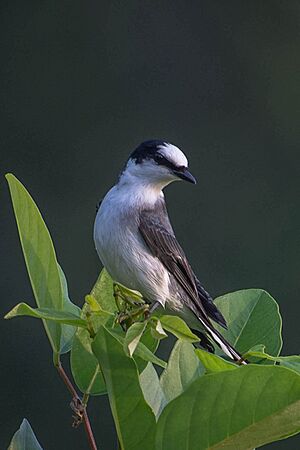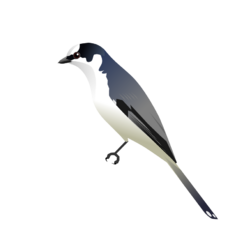Ashy minivet facts for kids
Quick facts for kids Ashy minivet |
|
|---|---|
 |
|
| Conservation status | |
| Scientific classification | |
| Synonyms | |
|
The ashy minivet (Pericrocotus divaricatus) is a type of passerine bird. Passerine birds are often called "perching birds" because they have special feet that help them grip branches. This bird belongs to the minivet group, which is part of the cuckooshrike family. You can find ashy minivets in eastern Asia.
Most minivets are known for their bright yellow, orange, or red feathers. But the ashy minivet is different! It only has shades of grey, white, and black. The male ashy minivet is easy to spot with its white face and black neck. However, the female can sometimes look similar to the female brown-rumped minivet. These birds like to search for food high up in the trees. They often join groups of different bird species to forage together.
What Does the Ashy Minivet Look Like?
The ashy minivet is about 18.5 to 20 centimeters (about 7 to 8 inches) long. The male bird has a grey back and a whitish belly. It has a black cap on its head with a white forehead. You can also see a white stripe across its flight feathers, which are the long, stiff feathers on its wings. The outer feathers of its tail are white too. Its beak and feet are black.
The female ashy minivet looks a bit different. Her cap is grey, but she has a black band between her beak and eye. There's also a thin white band just above that black stripe. When these birds call, they make a high-pitched, metallic trilling sound.
Scientists think the ashy minivet is closely related to the Pericrocotus roseus and Pericrocotus cantonensis minivets. However, it has a unique way of changing its feathers (called moulting). It's one of the few perching birds that moults its main wing feathers twice a year! It's also the minivet that travels the longest distances during migration.
Where Do Ashy Minivets Live and Travel?
Ashy minivets breed in places like south-east Siberia, north-east China, Korea, and Japan. Birds found in the Ryūkyū Islands of southern Japan are often considered a separate species, called the Ryukyu minivet (P. tegimae).
These birds are long-distance migrants. This means they fly very far to different places depending on the season. They spend their winters in South and South-east Asia, flying as far south as Sumatra, Borneo, and the Philippines.
You can find ashy minivets in forests. They also live in more open areas that have scattered trees. They search for insects in the tree canopy, which is the upper layer of the forest where the tree branches and leaves are. Sometimes, they join mixed-species foraging flocks, which are groups of different bird species looking for food together. When they are migrating, you can often see them flying in large flocks.
The number of ashy minivets in the world is considered stable. The IUCN (International Union for Conservation of Nature) lists them as a "least concern" species. This means they are not currently at risk of disappearing. For example, the number of ashy minivets on Amami Island was found to have increased between 1985 and 2001.
In the South Asian region, ashy minivets used to be considered rare. They were first officially seen on the Indian mainland in 1965. However, they had been reported from the Andaman Islands back in 1897. Since 1965, they have been seen more regularly in the region.
Ashy Minivet Families
Female ashy minivets usually lay between four and seven eggs. The parents then keep the eggs warm until they hatch. This incubation period lasts for about 17 to 18 days.



